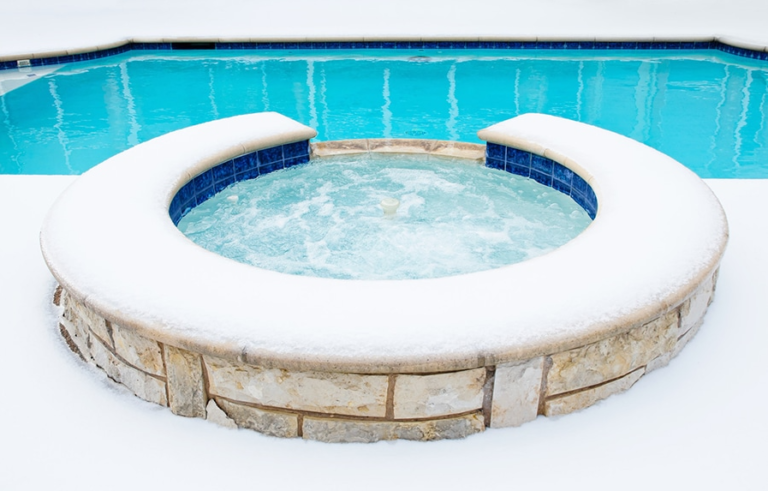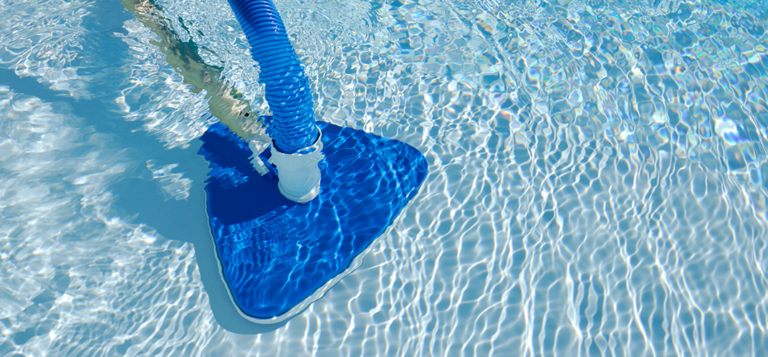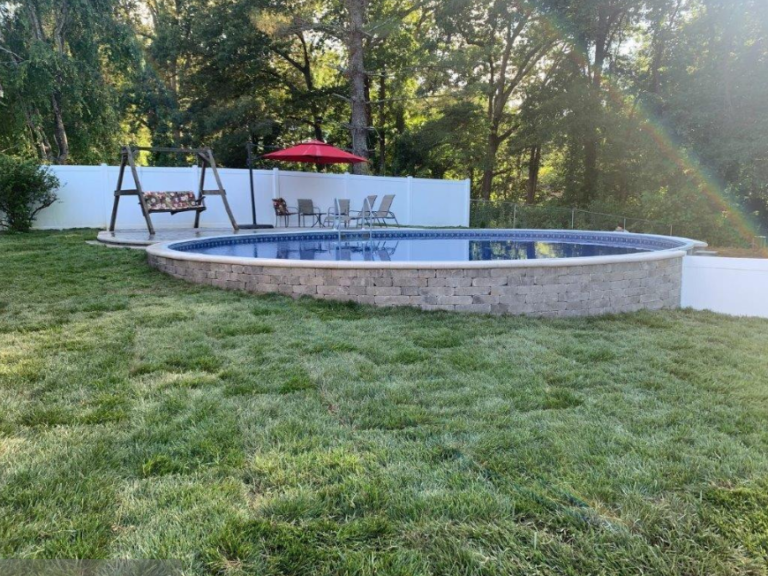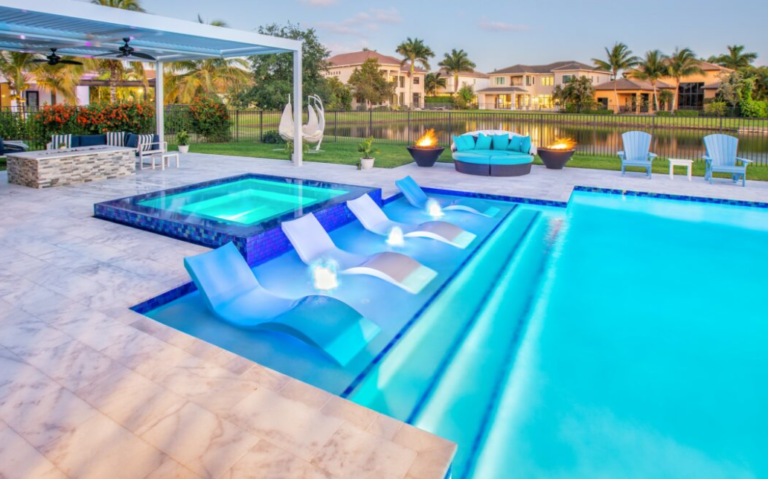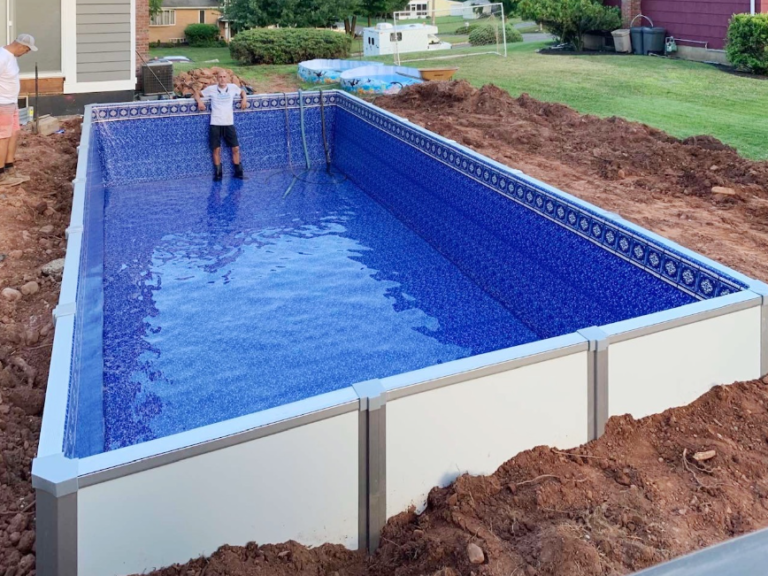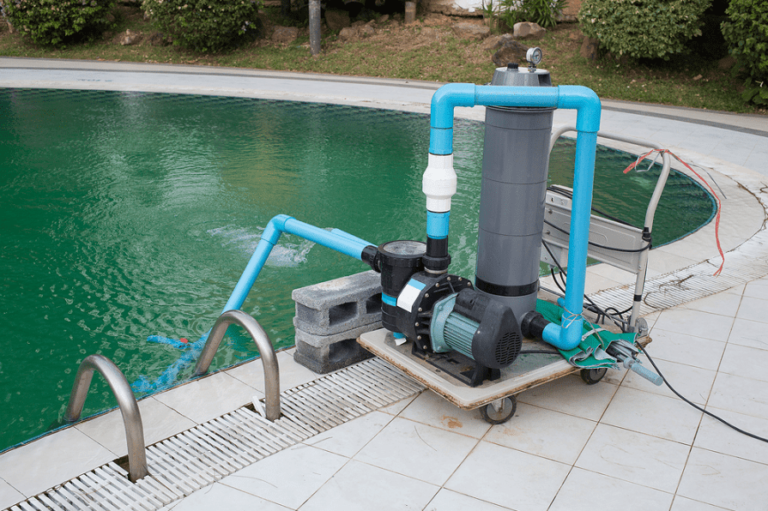All About Flocculant & its uses
Pool flocculant
Flocculant may sound like the white fluffy stuff you sprinkle on your fake Christmas tree, but it’s actually a useful chemical you can use to clear a cloudy pond.
In fact, this is probably the fastest way to clean a pool that you can’t clean with your own filtration system.
But if that’s not enough information for you, let’s talk about it a little more.
If you have cloudy water and want to clear it quickly, a pool flocculant can help. It is fast and effective in clearing cloudy water. But it won’t work in every cloudy pool situation. So when should you use flocculant? And when should you use a clarifier instead?
Here’s a quick guide to the difference between a flocculant and a clarifier and how to use a flocculant to clear cloudy water. You can watch the quick video below. Or keep reading for a complete pool flocculant tutorial. All pool owners, both personal and commercial, face the same problem every spring – a dirty pool. Dirt comes from a variety of causes: plaque, algae, a cracked pool cover that lets in leaves and dirt from rainwater, etc.
In this article, we have collected for you the 5 best pool flocculants that will make the process of pool cleaning easier. It will not only be faster and more efficient but also safer for your health. The top 5 flocculants selected by our team through in-depth research, also don’t blow your pocket.

Particles that are too small to be picked up by the filter make the pool water cloudy. Flocculant is an effective way to remove these particles.
Flocculant is safe to use and is commonly used in water treatment plants.
What is a Flocculant?
Flocculant, or pool floc as it’s sometimes called, is a chemical you add to your pool when other cleaning methods aren’t working.
Flocculants collect floating particles in water that are too small and light to sink to the bottom to be emptied. These particles typically include things like bacteria, viruses, algae spores, and other microscopic debris.
While it’s your pool filter’s job to filter out this debris, if the particles are microscopic, they can stay suspended in the water for a long time. When you put the fluke in the pond, it attracts all of these things and clumps it together in large clumps so that it is heavy enough to sink to the bottom of the pond, where it is either sucked up to the filter. will go or you can empty it. . With your pool cleaner…or just let a robotic pool cleaner take care of it if you want to do something else.
Pool flocculant, also known as pool floc, collects the tiny particles in your pool that cause cloudy water. Once those particles freeze, the larger clumps sink to the bottom of your swimming pool where they drain.
Pool flocculant, or “floc” as we Kiwis call it, is a very special chemical that every pool owner should keep on hand in their garden shed. Pool flocculant re-cleanses and purifies cloudy pool water.
It basically collects all the small specks floating in your pool that aren’t heavy enough to sink on their own. Then it combines them and sends them into the pool. We want these deposits to be at the bottom of the pool so they can be cleaned with a pool vacuum. Consider dusting the corners of your windows or cleaning out a few stray cobwebs to make your home that much cleaner. What is in these “fish nets”? Mostly bacteria, algae spores, viruses, and other microscopic particles (harder to see than other debris).
The whole point of a floc is just to get these microparticles in a place where they can be removed from the pool. Flocking is not difficult but can be frustrating at times. That’s why we’re here to talk to you about how to successfully add flocculants to your pool cleaning.
What are the Disadvantages of Pool Flocculant?
Before you choose a pool flocculant over a pool clarifier, there are a few reasons why it may not be ideal:
- Pool flocculant needs more work. Once the clumps form on the bottom of the pool, you will need to remove them with a manual pool vacuum. An automatic pool vacuum will not work.
- You will lose pool water using a pool flocculant. When you vacuum the clips, you will need to vacuum on the “waste” setting and bypass the filter. All that water will drain out of your pond and your water level will drop.
- You cannot use a pool flocculant with cartridge filters. Unless you have a custom plumbing setup that allows you to bypass the filter when vacuuming, you will not be able to use pool flocculant with a cartridge filter system.
- By the way, if you want to learn how to never deal with cloudy water again, check out our Pool Maintenance Video Course! Here’s a step-by-step guide to show you how to prevent pool problems before they get out of hand.

When you’re in a fix.
The main motivation to use floc is when you need to clear your cloudy pool ASAP because you plan to use it very soon! Floc works well in a matter of hours. It’s highly efficient and will make your pool cloud-free again in no time.
But before you run off to put it in your pool, wait! This is the second part!
You will need to vacuum later. Those newly made pool nets will sink to the bottom and sit there, ruining the view of your swim. Make sure you have time to empty your pool to complete the process. While we highly recommend robotic vacuum cleaners over manual vacuum cleaners, to save time, water, and electricity, manual vacuuming is definitely the way to go as an easy fluke fix!
How to get a fluke out of a pool
Too much flocculant means it will start to stick to itself over and above the bacteria and algae spores we’re trying to clean. The problem with this happening is that it won’t sink to the bottom. It will float in your pool and start causing more problems, such as clogging your pool filter.
If you get a little too excited when adding the fluke, leave the pond alone for a few more days to give it more time to sink to the bottom. It is recommended not to swim while in the fluke pool. As you can imagine, this is not very pleasant and can irritate your skin.
Vacuum again after a few days, even multiple times if needed, to clean out the debris that has hopefully settled by now. If it still doesn’t work, you’ll need to empty and refill the pool to start over.
Tips and Tricks for Choosing the Most Suitable Floc Pool

Visiting various online marketplaces or regular store products for swimming pools near home, you may get confused by the variety of products offered there. And immediately the question “What do I need to buy?” arises in your mind without an answer. We are ready to help you answer it.
When choosing the best suitable flocculant for you, pay attention to the 5 most important criteria described below.
- Performance in pool cleaning.
You should explore how each product is good at getting results after the cleansing process. Before buying you can see some reviews of real users where people write their experience: is floc effective or not.
The basic chemical composition of most flocculants is aluminum sulfate. To use this chemical effectively, make sure you follow the directions correctly. You should also check the condition of the pool water before using flocculants: make sure the pH and alkalinity of the water are correct according to the instructions, etc. Aluminum sulfate can lower the pH level of pool water, so with some flocculants based on this ingredient, consumers are advised to adjust the pH to 7.5 or higher before cleaning. We do not recommend that you mix several chemicals at the same time, as this can significantly damage the condition of the water, the surface of the pool, and its filters.
- Cleaning speed.
It’s no secret that a certain fluke for pools is capable of cleaning dirt for up to 12 hours, while another can give you results after 24 hours or even more. You should consider this criterion when choosing a pool flux for yourself. If you are looking for the fastest cleaning flocculant, we recommend choosing Pool Mate Liquid Drop Down Swimming Pool Flocculant.
- Contributes well to the complete adhesion of debris to the bottom of the pool.
The main difference between a pool clarifier and a flocculant is that the latter chemical contributes to the adhesion of small dirt particles and then carries them downstream. This well-executed function will help you vacuum the pool easily and get rid of debris. Also, if all debris is removed from the bottom, a completely clean pool will not need to be cleaned 2 or more times.
- Easy to use.
- Sometimes the process of cleaning the pool raises a lot of questions as it seems very complicated and time consuming.
- For your convenience, we have collected some more information about the best products in this category in our article below. Spoiler: The most effective pool cleaner is Pool Basics Dropdown Liquid Flocculant.
- Some pool cleaners require a lot of money and effort to use. But not so with pool flocculants.
- More often than not, the cleaning process is made easier thanks to the product’s clear and easy-to-follow instructions. Later in this article, we take an in-depth look at the winning products in this category. We strongly advise you to ensure that the product comes with proper instructions before purchasing.
- Low consumption.
- It is very important for pool flocculant users that the product is not over-usable. This directly affects how often and in what quantity it should be purchased.
The most influential factor in this is the size of your pool. It is also affected by the purpose for which you are using the chemical: to remove a lot of dirt or to do routine cleaning. The maximum amount of flocculant to use is 1 bottle (4 oz) per 5,000-gallon pool. Based on our research, we recommend 2 great products for this feature: Poolmate Liquid Dropdown Swimming Pool Flocculant and Swim Super Flocout.
Pool flocculant wold note by me last choke to there still comms to clear cloudy pool water.
They?
You’re generally better off not adding extra chemicals to your pool if you can help it. A properly balanced pool with adequate filtration should be sufficient for clean water.
However, if you have limited time to clean your pool water or the water is particularly cloudy, a flocculant is a good choice – maybe you have a party the next day and the pool looks great. need to
Although there is considerable manual work involved in cleaning the dirt left by the flocculant. If you have a week or so to spare, a pool clarifier might be a better choice – more on the clarifier later.
- How long does Pool Flocculant take to work?
- Pool flocking is not usually a last-minute activity. Yes, it’s early. But that’s a fast 24 hours.
- It takes 2 hours for the pool pump to turn on and at least 8 hours for the pump to turn off. Then the pool needs to be emptied. It’s a quicker fix than a full deep clean, but it still requires a bit of foresight and forward planning.
- As soon as you’ve vacuumed and rebalanced the water chemistry, your pool is good to go again!
Pool flocculant can clear your cloudy pool water in 1 or 2 days. Although it works faster than pool clarifiers, it will take 8 to 16 hours to collect the particles before you need to vacuum. Add flocculant to your pool with your filter on “recirculation”. Then turn off your pool pump and let the flocculant sit overnight. Once it settles to the bottom of your pool, use a manual vacuum to remove all the frozen particles.
How to use Flocculant
First! Get your hands on some flocculant products. Flocculants can come in granular or liquid forms. We recommend Focus Quick Floc Clarifier or Focus Granular Pool Floc.
Before using pool flocculant, make sure your pool filter has a “waste” setting. Remember, frozen particles cannot be removed from your filter, so you must be able to bypass your filter and vacuum the water from your pool.
Stepwise Use of Flocculant
- Change the filter to the ‘Recirculate’ setting.
- Make sure your pool has a balanced pH level (between 7.4 and 7.6).
- Read the directions on the package of your flocculant. You must add the correct amount according to the size of your pool.
- Once added, run the pool pump for two hours to circulate it properly and distribute it evenly.
- Turn off the pump and let the pool water sit for 8 hours.
- After 8 hours, change your filter setting to ‘Waste’, as it’s time to vacuum the pool and remove the dirt deposits (pool traps) from the bottom.
- Check the pool water level. It must have gone down, because you are vacuuming for ‘waste’, meaning you are removing water from the pool. Use a garden hose to refill your pond, and then rebalance your water chemistry.
- Set the filter to recirculate.
- Turn the multiport valve on your sand filter or DE filter to “recirculate”. Do not allow pool flocculant to enter your filter. This will block everything making your filter useless until you completely replace the filter medium.
- 2. pH balance
- Your pH should be between 7.4 and 7.6 before adding pool fluke. Check your water level. Then, adjust your pH with a pH raiser or pH reducer.
- 3. Add Flocculant (Floc) to the pool water.
- Add the correct amount of flocculant based on your size pool. If you need help figuring out the size of your pool, you can use a pool calculator to help you. Be sure to read the manufacturer’s instructions before adding any chemicals to your water.
- Our recommendation for pool flocculant is:
- Fast Fluke by Swim University
- A fast-acting formula that drops cloudy water particles to the bottom of the pool so you can empty it. Fast Fluke will help you quickly remove dead algae and non-living organic pollutants from your pond.
- It is safe for all pools and filters including in-ground, above ground, concrete, plaster, fiberglass, vinyl liner, and more.
- Circulate the flocculant.
- Run the pool pump for two hours to circulate the fluke throughout the water. Remember to set your filter to “recirculate”, not “filter”.
- Let the Pool Flocculant sit for 8 hours.
- Turn off your pump and let the pool sit for at least eight hours. This is easiest to do overnight. If your system has an automatic timer set, remember to turn it off.
- 6. Vacuum particle clips outside the pool
- Set your pool filter to “waste” and connect your manual vacuum.
- If you don’t have a multi-port valve, open the drain port of your filter and let the water drain out while vacuuming. And if you need help vacuuming your pool, be sure to check out our guide on how to use a manual pool vacuum.
- When you vacuum clumps of particles from the bottom of your pool, the motion can stir up the particles and re-cloud your pool. If this happens, take a break, let the particles settle, then start vacuuming again. Try to move slowly. And you may need to vacuum two or three times to remove all the clips.
- Check the pool water level.
- If your water level has gone down (it’s likely), use a garden hose with a filter to add fresh, clean water and bring the level back up to where it needs to be. You can also hold the hose in the pool while you’re vacuuming, although this can stir up particles.
- Test and balance water
- Since you have removed and replaced the water in your pool, you will need to balance your water chemistry. Test your pool water and adjust your alkalinity and pH. Once those levels are balanced, add chlorine. Run your filter system as normal while balancing the water.
What are the Benefits of Pool Flocculant?
In many cloudy water conditions, pool flocculants are an effective option for cleaning your pool:
- The pool flocculant works fast. Unlike a clarifier, you don’t have to wait days for the flocculant to work. The particles quickly clump together and sink to your pool floor within hours.
- Pool flocculant is very effective. The flocculant holds the particles together until you remove them from the vacuum. No more cloudy spots in your swimming pool water.
- Pool flocculant works well with sand filters and diatomaceous earth or DE filters. These filters have multiport valves that include a “waste” setting. And that means it’s easy to bypass the filter when vacuuming up accumulated particles and flocculants.
Frequently Asked Questions About Pool Flocculant
Looking for more help using Poll Fluke? Here are some common questions and answers.
- Can you swim in cloudy pond water?
No, you should not swim in cloudy pool water. A cloudy pond is full of pollutants that can cause eye irritation. Reduced visibility also increases the risk of drowning. Avoid swimming in your pool until the water is clear.
- When should I add flocculants to my pool water?
If you have cloudy water but your water chemistry is balanced (pH, alkalinity, and chlorine levels) and your filters are clean, add pool flocculant. Adding fluke is also useful after a rainstorm when debris and wastewater enter your pond or if you have early-stage algae growth. Since the pool flocculant needs 8 to 16 hours to work in your water, adding it in the evening and letting it sit overnight is most helpful.
- Can you use Flocculant and Algaecide together?
As with any chemical, you should never add algaecide and pool flocculant at the same time.to your pool water. But pool flocculant is useful in fighting the early stages of algae growth. This helps bind floating algae particles, making it easier to flush them out of your pool.
- Can I use aluminum sulfate as a pool flocculant?
Yes, you can use aluminum sulfate, also known as alum floc, as a pool flocculant. Look for food grade, garden grade, or technical grade aluminum sulfate. Depending on the condition of your pond, you may want to use 4 pounds of alum per 10,000 gallons of water. It works just like packaged pool flocculant, so make sure your water chemistry is balanced before adding it and be sure to vacuum to dispose of it.
- Can You Use Too Much Pool Flocculant?
Yes! Using too much pool flocculant can actually make your pool water more cloudy. As with any other pool chemical, be sure to follow the manufacturer’s instructions and add the appropriate amount based on the size of your pool.
If you constantly need to use a pool flocculant or clarifier, check that you are cleaning. Or backwash your filtration system regularly. And be sure to keep your pH levels balanced. If you need more help with water chemistry, be sure to check out our Basic Pool Chemistry 101 guide.
- How much Floc is too much Floc?
Oh, this seems to be a common finding. The amount of flocculant your pool needs depends on a few things, such as:
- Your pH level, so it’s important to balance it first.
- The volume of water in your pool.
- The type or brand of flocculant you are using.
- Using too much floc can make your pool look even more cloudy, which is why some people are disappointed with this product.
So, how do you calculate the right amount of fluke for your pool?
We recommend using a pool calculator to find out how much water your pool holds, or contact your pool expert who can tell you based on a few key details.
The amount of floc that needs to be mixed depends on how much water you have in your pond. Calculate carefully, otherwise, you may join the desperate flossers of the Internet!
Recommended guides
The truth about phosphates in pool water
You’ve probably heard that phosphate remover is essential for pool maintenance. We did some research and the truth is, it’s not. Learn why you should save your money.
Alkalinity is too high? Here’s how to quickly reduce pool alkalinity.
If your total alkalinity level is too high, here’s how to reduce pool alkalinity with either muriatic acid or a pH reducer.
CYA levels are low? Here’s how to increase cyanuric acid in a pond.
Need to increase cyanuric acid in your pool? Here are two easy ways to bring up CYA levels in your pool.
How to lower pool pH with these common chemicals.
Is your pool’s pH level too high? Here’s how to lower the pH in a pond using a pH reducer or muriatic acid.
How to Clean Your Pool with Flocculant :
Depending on how well your pool is being maintained, you may already know about this magical product called pool flocculant. Or if you’re just hearing about it for the first time, it’s probably because you’re having a cloudy water problem in your pool.
In this guide, we’ll tell you what pool flocculant is, how to use it (with instructions), what to do when it doesn’t seem to be working, and the best pool cleaning agents. Some hot tips to deal with.
- What is Pool Flocculant?
- Comparison between Flocculant and Clarifier
- In what situations should you consider using a flocculant?
- When you’re in a fix.
- As part of a deep cleaning
- How to use Flocculant
- Stepwise Use of Flocculant
- Our pool fluke hot tips
- How long does pool flocculant take to work?
- How much Floc is too much Floc?
- How to get fluke out of a pool
- Common Problems with Pool Flocculants
- Pool fluke not sinking?
- Pool still cloudy after fluke?
- Pole fluke not working?
- Pool fluke making you flop?
As part of a deep cleaning
It’s true, you can use flocculant even when you don’t need it, just for that extra sparkling water effect. From our guide to pool maintenance, you’ll find that there are three main steps to cleaning your pool:
- Skimming the surface.
- Brushing your pool.
- Vacuuming your pool.
If you want to add ‘flocking’ to the process, do so between brushing your pool and vacuuming your pool (noting that you have to vacuum as part of the process).
Let’s dive into what exactly the process is.
Our pool fluke hot tips
- Flocking is best done in the evening: you can add the fluke, run the pump for 2 hours, then leave it overnight for 8 hours and vacuum the next morning. Have a pool party on Saturday? You’ll have sparkling water until Friday night rolls around and your guests arrive. Slowly vacuum! The motion of the vacuum will agitate the deposit. To prevent them from floating back (and being inaccessible to the vacuum), be gentle with the vacuum head. You can even vacuum twice to catch everything.
- Normally when vacuuming the ‘waste’, you can run a garden hose into the pond to keep the water level constant. But when vacuuming after flocking, we recommend turning the water up afterward, as the water flow will also disturb the debris below.
- Poll Fluke Fluttering You?
- We’re here to give you the confidence you need when it comes to pool flocking. With a little advice from the experts, you’ll be cleaning your pool clouds like a pro and telling all your BBQ friends about the wonders of pool flocculant.
Need more help with pool maintenance?
- Download our free pool care cheat sheet. This is a free, easy-to-use guide to help you keep track of your pool maintenance.
- Subscribe to our Swim University YouTube channel. We publish free video tutorials throughout the pool season.
- Check out our pool care course. You’ll find 30+ step-by-step videos and a downloadable step-by-step guide with everything you need to know about pool care.
Why should you trust our research?
To help you make a quick and accurate decision, we’ve selected the top 5 flocculants in 2022. So why is this special? Let’s get to the bottom of it.
Before we decided on the top 5 products according to consumers, our team found 9 pool flocculants that we further researched. We studied over 2,000 ratings and user reviews to highlight important criteria for product testing and rating.
It is worth noting that we studied not only positive reviews but also negative ones in a 1:1 ratio. This gives a more objective result, as all products had more positive reviews than negative ones.
Based on the results, we selected the 5 best flocculants, which we will describe in more detail below. To facilitate a quick decision, we have also highlighted the key categories in which each chemical is a leader. All of these results for the top 5 flocculants are based on 1,000+ real user experiences.
What is Pool Flocculant?
Pool flocculant, or “floc” as we Kiwis like to call it, is a very special chemical that every pool owner should keep on hand in their garden shed. Pool flocculant re-cleans and clears cloudy pool water.
It basically collects all the small specks floating in your pool that aren’t heavy enough to sink on their own. Then it joins them together, and sends them down the pond. We want these deposits to be at the bottom of the pool so they can be cleaned with a pool vacuum. Consider dusting the corners of your windows or cleaning out a few stray cobwebs to make your home that much cleaner. What is in these “fish nets”? Mostly bacteria, algae spores, viruses, and other microscopic particles (harder to see than other debris).
The whole point of a floc is just to get these microparticles in a place where they can be removed from the pool. Flocking is not difficult but can be frustrating at times. That’s why we’re here to talk to you about how to successfully add flocculants to your pool cleaning.
Comparison between Flocculant and Clarifier
Pool flocculants freeze small particles into larger flocs that sink to the bottom of the pool. Floc is faster and more efficient than a clarifier, but requires more work and must be removed manually with a pool vacuum. A pool clarifier, on the other hand, collects the particles into small flakes that are removed by the pool filter. It’s easier to use than floc, but it’s not as powerful and usually takes longer to clean your pool water.
Flocculant Disadvantages:
- Cannot be used with cartridge filters.
- More work is needed – followed by vacuuming when it settles again.
- It loses pool water while vacuuming.
- When to use flocculant:
- When you want to clean your pool ASAP for a party and have time for vacuuming.
Obvious Disadvantages:
- Works slowly, may take days depending on cloudiness.
- The pool filter needs cleaning afterward.
- When to use a clarifier:
- When you’ve just opened your pool or any time it’s looking a little cloudy.
Flocculant
- Similar to clarifiers, floc binds smaller particles into larger, larger masses, such as pond nets.
- These nets are then so heavy that they sink to the bottom instead of being caught by the pond filter.
The clarifier
- Contains polymers that bind together the tiny particles that cloud your pool.
- These particles are then large enough to be captured by the pool filter.
- After the filter captures them, you will need to clean your pool filter.
Clarifying Benefits:
- Cures light cloudiness.
- saves water.
- Can be used anytime to promote clean water.
Advantages of flocculants:
- It works fast in a matter of hours.
- It’s effective – no particles are left behind.
- Ideal for sand and DE filters, which are most common in New Zealand.
You may have heard more about pool clarifiers than flocculants because they are usually used a bit more. Both products are coagulants, but the main difference is the time the products take to work.
A clarifier is a mild chemical that will take several days to completely clear a cloudy pond, while a flocculant works almost immediately.
So, why don’t you always use a flocculant, you ask? Mainly because it requires a lot of work.
How to clean a pond
When you decide to use flocculants to clean your pool, it’s a fairly simple process. Here’s what you need to do:
1. Raise the water level.
You’re likely to lose some water during the vacuuming process, so it’s best to go ahead and fill it to its highest level.
That way you don’t run the risk of water getting under the filters. You want your pump to do its job during this process.
2. Balance the pH level at about 7.0
Since flocculants can affect the pH level, you’ll want to start it at around 7.0 to ensure your sanitizer is working at peak efficiency.
3. Dilute the flocculant.
Read the directions on the bottle to find out how much water to add to dilute the product.
A five-gallon bucket is a great container to mix it in.
4. Add the flocculant to the pool.
Pour diluted flocculant around the edges of the pond.
5. Run the pool pump for a few hours.
This allows the flocculant to disperse into every area of the pool.
6. Turn off the pump and let it set overnight.
This is when the flocculant does its job. The water needs to be as still as possible for about 8 hours so that it has time to collect waste.
7. Set the filter valve to “waste”.
8. Activate the pump.
After these 8 hours, you will see sediment at the bottom of your pond, probably in the form of a large ring. You’ll want to turn the pump on so it can start filtering it.
9. Vacuum under the pool.
Your filter and vacuum will be doing double duty to remove all that junk. Be careful to vacuum up anything left behind by your pump.
10. Change the water.
You likely lost some water during the vacuuming process, so you’ll want to get it back to normal right away.
11. Backwash the pool filters.
Wash your filters thoroughly to remove all sediment and chemical residue.
Result
Flocculant is a great way to clean your pool quickly, but you should only use chemicals when you have time to vacuum really well after everything has been collected.
If your pool is a bit cloudy, we recommend using a clarifier first to see if it helps. With a clarifier, you can still swim while it’s working, but you may have to wait a few days to see results.
Either way, there’s always a way to purify your water: you just have to find the right product and decide how long you can wait to see results.
Different types of pools require different levels of maintenance, including different amounts of chemicals such as flocculants. If you’re still trying to figure out what type of pool you’ll be happiest with in the long run, taking into account flocculant usage and other maintenance requirements, why not take our pool type quiz Find out what you really want. Just click the button below to get started — it’s fast, easy, and free!

